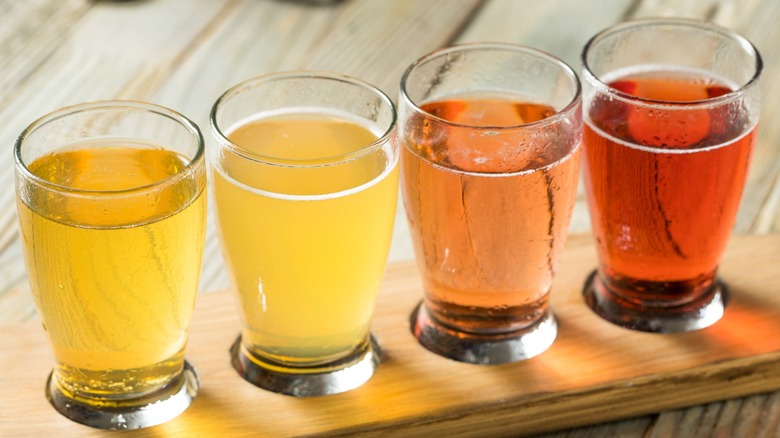Why You Shouldn't Drink Cider That's Too Cold
With fall just around the corner, it's nearly time to fill the fridge with some cool, crisp hard cider to celebrate the changing of the seasons. Made from fermented apple juice, hard cider evokes that comforting flavor of autumn you just don't get with a glass of wine or a beer. There are plenty of hard cider brands on the market to choose from, so when you're out picking up ingredients to make an apple pie, be sure to throw a cold cider or two into your cart to drink while you bake. Though its flavor is unmatched under most circumstances, to properly enjoy a cider, it's important that it isn't ice cold, or else you'll miss out on all those hidden appley aromatics.
Similar to wine, there is an optimal temperature that cider should be enjoyed at, depending on the type of cider. For sweeter ciders, try drinking it at 40 to 45 degrees Fahrenheit. Craft ciders, meanwhile, are best enjoyed at 50 to 55 degrees Fahrenheit. And if your cider is particularly dry, let it sit out a little longer and try drinking it even closer to room temperature. This will ensure that all of the tannins and other flavor attributes are present and that your taste buds aren't distracted by the intensity of the cold. Try chilling your cider for a few hours, and then letting it sit out uncovered for a few minutes to reach optimal temperature: You don't want it too cold, but you don't want it too warm, either, as this can also eliminate much of the flavor.
Get the most out of your cider
If you're looking to spice things up a bit this fall, there are a few important tips beyond temperature control that can help you get the most out of a glass of hard cider. One thing to be especially aware of is the type of cocktail glass you're drinking out of. Bars will typically serve cider in a beer or pint glass, but cider should actually be served in something like a fluted glass so that the bubbles are properly preserved. Whether you choose to go with a fluted glass or not, the glass you choose should have a stem so that the warmth of your hands doesn't affect the temperature of the beverage.
If you're looking to host a cider tasting this fall, it's important to choose and taste your ciders carefully, just like you would at a wine or beer tasting; this will allow you to create the ultimate cider tasting just like an expert. When deciding which ciders to include, be sure to offer a well-rounded variety, from more basic still ciders to sparkling ciders, to fruit ciders and off-dry ones. Once you've got your selection of cider, be prudent with your tasting. Notice the aroma, flavors, carbonation, and texture, and allow each delicious note to slowly reveal itself.

